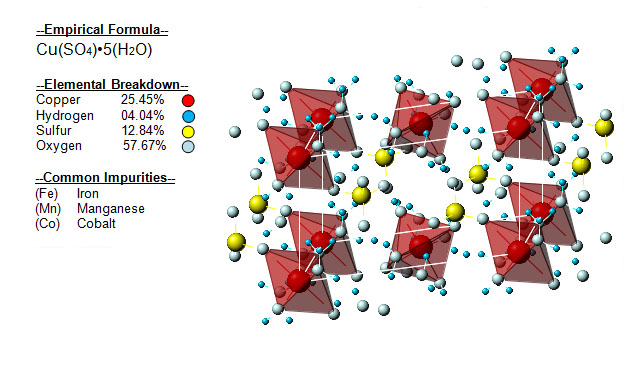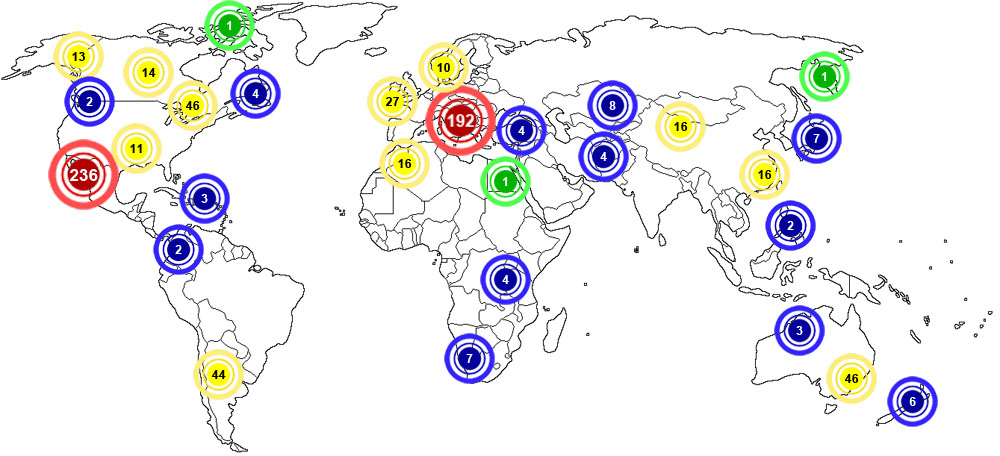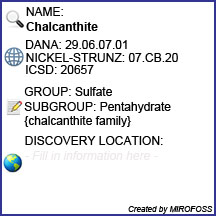

| Mineral Name | Chalcanthite |
| First Discovered | Prehistoric, Exact Year Unknown |
| Nickel-Strunz Classification | 07.CB.20 |
| Dana Classification | 29.06.07.01 |
| ICSD | 20657 |
| Mineral Group | Sulfates |


| Cleavage | Indistinct to Imperfect |
| Colour(s) | Green, Green blue, Light blue, Dark blue |
| Specific Gravity | 2.21 |
| Diaphaneity | Translucent to Sub transparent |
| Fracture | Conchoidal |
| Mohs Hardness | 2.5 |
| Luminescence | Non-fluorescent |
| Lustre | Vitreous |
| Streak | White |
| Habit(s) | Encrustations to Reniform to Stalactitic |
| Radioactivity | Non-radioactive |
| Magnetism | Diamagnetic |

The following health hazards should be noted when handling chalcanthite
 |
TOXIC Chalcanthite is fatal if ingested and will also stain the skin for several days. |
 |
ENVIORNMENTAL HAZARD Chalcanthite has a mildly sweet taste and may be ingested, although fatal, by animals. |

The following image shows the Elemental breakdown of the mineral chalcanthite along with the mineral crystal structure.


| Crystal System | Triclinic |  |
| Class | Pinacoidal | |
| Axial Ratios | a : b : c = 0.5719 : 1 : 0.5579 | |
| Optical Data Type | Biaxial (-) | |
| Pleochroism (x) | N/A | |
| Pleochroism (y) | N/A |  |
| RL Values | nα = 1.514 nβ = 1.537 nγ = 1.543 | |
| 2V | Measured: 56° , Calculated: 56° | |
| Max Birefringence | δ = 0.029 (See colour chart at right) | |
| Surface Relief | Low | |
| Dispersion | Weak r < v |

Chalcanthite can be referenced in certain current and historical texts under the following seven names:
The mineral chalcanthite can be translated into the following select languages:
| Arabic | Bulgarian | Chinese (Sim) | 胆矾 | ||
| Croatian | Czech | Chalkantit | Danish | ||
| Dutch | Chalcanthiet | Esperanto | Estonian | ||
| Finnish | French | Chalcantite | German | Chalkanthit | |
| Greek | Hebrew | Hungarian | Kalkantit | ||
| Italian | Calcantite | Japanese | 胆礬 | Korean | 찰칸차잍 |
| Latin | Chalcanthum | Lithuanian | Norwegian | ||
| Persian | Polish | Chalkantyt | Portuguese | Calcantite | |
| Romanian | Russian | Халькантит | Slovak | Chalkantit | |
| Spanish | Chalcantita | Swedish | Tagalog | ||
| Turkish | Ukrainian | Халькантит | Vietnamese |

Chalcanthite is considered to be abundant around the world. The map below shows major documented concentrations of chalcanthite:


 |
The MIROFOSS database offers free printable geological identification tags for personal and non-profit use. These tags can be used to properly identify mineral samples in your collection. -Click here- to download a full size jpeg image for a chalcanthite identification tag; which can be printed on paper or used with a plastic laser printer. |
 |
What's this? What can I do with it? |

| Crystallography | Bandy (1938) American Mineralogist: 23: 718. |
| History | Palache, C., Berman, H., & Frondel, C. (1951), The System of Mineralogy of James Dwight Dana and Edward Salisbury Dana, Yale University 1837-1892, Volume II. John Wiley and Sons, Inc., New York, 7th edition, revised and enlarged, 1124 pp.: 488-491. |
| History | Gaines, Richard V., H. Catherine, W. Skinner, Eugene E. Foord, Brian Mason, Abraham Rosenzweig (1997), Dana's New Mineralogy : The System of Mineralogy of James Dwight Dana and Edward Salisbury Dana, 8th. edition: 605. |
| Geographical Data | Mindat.org. Retrieved on 2013-02-04 |
| Physical Identification | Webmineral.com. Retrieved on 2013-02-04. |
| February 04, 2013 | The last time this page was updated |
 |